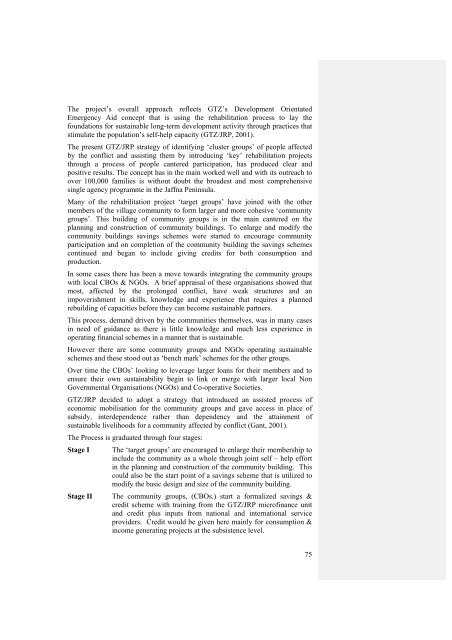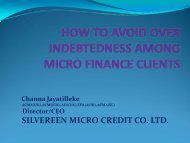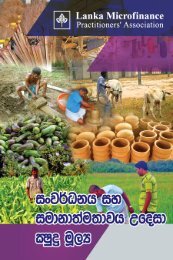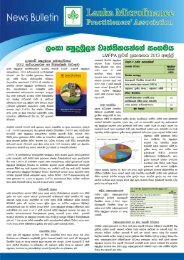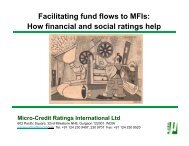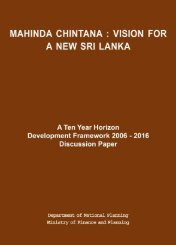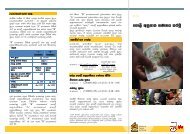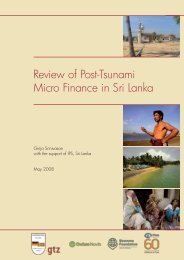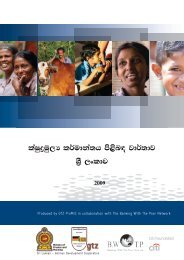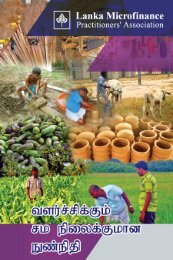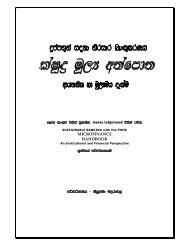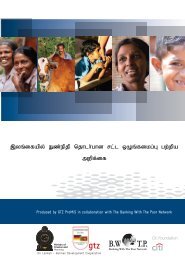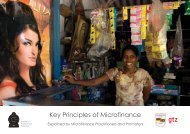National Microfinance Study of Sri Lanka: Survey of Practices and ...
National Microfinance Study of Sri Lanka: Survey of Practices and ...
National Microfinance Study of Sri Lanka: Survey of Practices and ...
You also want an ePaper? Increase the reach of your titles
YUMPU automatically turns print PDFs into web optimized ePapers that Google loves.
The project’s overall approach reflects GTZ’s Development Orientated<br />
Emergency Aid concept that is using the rehabilitation process to lay the<br />
foundations for sustainable long-term development activity through practices that<br />
stimulate the population’s self-help capacity (GTZ/JRP, 2001).<br />
The present GTZ/JRP strategy <strong>of</strong> identifying ‘cluster groups’ <strong>of</strong> people affected<br />
by the conflict <strong>and</strong> assisting them by introducing ‘key’ rehabilitation projects<br />
through a process <strong>of</strong> people cantered participation, has produced clear <strong>and</strong><br />
positive results. The concept has in the main worked well <strong>and</strong> with its outreach to<br />
over 100,000 families is without doubt the broadest <strong>and</strong> most comprehensive<br />
single agency programme in the Jaffna Peninsula.<br />
Many <strong>of</strong> the rehabilitation project ‘target groups’ have joined with the other<br />
members <strong>of</strong> the village community to form larger <strong>and</strong> more cohesive ‘community<br />
groups’. This building <strong>of</strong> community groups is in the main cantered on the<br />
planning <strong>and</strong> construction <strong>of</strong> community buildings. To enlarge <strong>and</strong> modify the<br />
community buildings savings schemes were started to encourage community<br />
participation <strong>and</strong> on completion <strong>of</strong> the community building the savings schemes<br />
continued <strong>and</strong> began to include giving credits for both consumption <strong>and</strong><br />
production.<br />
In some cases there has been a move towards integrating the community groups<br />
with local CBOs & NGOs. A brief appraisal <strong>of</strong> these organisations showed that<br />
most, affected by the prolonged conflict, have weak structures <strong>and</strong> an<br />
impoverishment in skills, knowledge <strong>and</strong> experience that requires a planned<br />
rebuilding <strong>of</strong> capacities before they can become sustainable partners.<br />
This process, dem<strong>and</strong> driven by the communities themselves, was in many cases<br />
in need <strong>of</strong> guidance as there is little knowledge <strong>and</strong> much less experience in<br />
operating financial schemes in a manner that is sustainable.<br />
However there are some community groups <strong>and</strong> NGOs operating sustainable<br />
schemes <strong>and</strong> these stood out as ‘bench mark’ schemes for the other groups.<br />
Over time the CBOs’ looking to leverage larger loans for their members <strong>and</strong> to<br />
ensure their own sustainability begin to link or merge with larger local Non<br />
Governmental Organisations (NGOs) <strong>and</strong> Co-operative Societies.<br />
GTZ/JRP decided to adopt a strategy that introduced an assisted process <strong>of</strong><br />
economic mobilisation for the community groups <strong>and</strong> gave access in place <strong>of</strong><br />
subsidy, interdependence rather than dependency <strong>and</strong> the attainment <strong>of</strong><br />
sustainable livelihoods for a community affected by conflict (Gant, 2001).<br />
The Process is graduated through four stages:<br />
Stage I The ‘target groups’ are encouraged to enlarge their membership to<br />
include the community as a whole through joint self – help effort<br />
in the planning <strong>and</strong> construction <strong>of</strong> the community building. This<br />
could also be the start point <strong>of</strong> a savings scheme that is utilized to<br />
modify the basic design <strong>and</strong> size <strong>of</strong> the community building.<br />
Stage II The community groups, (CBOs.) start a formalized savings &<br />
credit scheme with training from the GTZ/JRP micr<strong>of</strong>inance unit<br />
<strong>and</strong> credit plus inputs from national <strong>and</strong> international service<br />
providers. Credit would be given here mainly for consumption &<br />
income generating projects at the subsistence level.<br />
75


